engine CHEVROLET COLORADO 2005 1.G Workshop Manual
[x] Cancel search | Manufacturer: CHEVROLET, Model Year: 2005, Model line: COLORADO, Model: CHEVROLET COLORADO 2005 1.GPages: 414, PDF Size: 2.57 MB
Page 253 of 414

To identify what the vehicle trailering capacity is for your
vehicle, you should read the information in “Weight of
the Trailer” that appears later in this section.
If yours was built with trailering options, as many are,
it’s ready for heavier trailers. But trailering is different
than just driving your vehicle by itself. Trailering means
changes in handling, acceleration, braking, durability
and fuel economy. Successful, safe trailering takes
correct equipment, and it has to be used properly.
That’s the reason for this part. In it are many time-tested,
important trailering tips and safety rules. Many of
these are important for your safety and that of your
passengers. So please read this section carefully before
you pull a trailer.
If You Do Decide To Pull A Trailer
If you do, here are some important points:
There are many different laws, including speed limit
restrictions, having to do with trailering. Make sure
your rig will be legal, not only where you live
but also where you’ll be driving. A good source for
this information can be state or provincial police.
Consider using a sway control. You can ask a hitch
dealer about sway controls.
Don’t tow a trailer at all during the �rst 500 miles
(800 km) your new vehicle is driven. Your engine,
axle or other parts could be damaged.
Then, during the �rst 500 miles (800 km) that you
tow a trailer, don’t drive over 50 mph (80 km/h)
and don’t make starts at full throttle. This helps your
engine and other parts of your vehicle wear in at
the heavier loads.
You may want to shift the transmission to THIRD (3)
or, if necessary, a lower gear selection if the
transmission shifts too often (e.g., under heavy
loads and/or hilly conditions). If you have a manual
transmission and you are towing a trailer, it’s
better not to use the highest gear.
Three important considerations have to do with weight:
the weight of the trailer,
the weight of the trailer tongue
and the weight on your vehicle’s tires.
4-55
Page 254 of 414
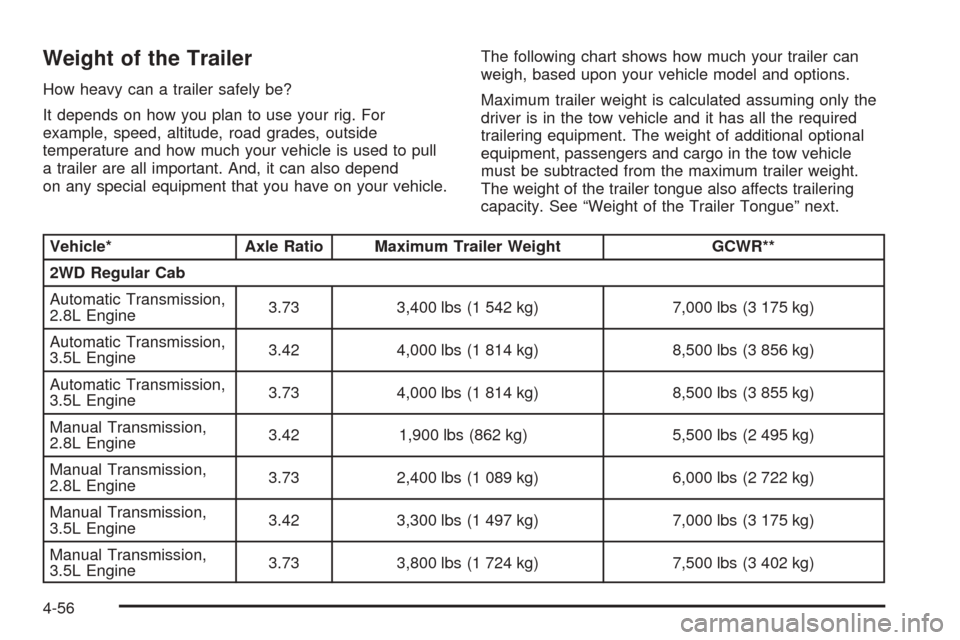
Weight of the Trailer
How heavy can a trailer safely be?
It depends on how you plan to use your rig. For
example, speed, altitude, road grades, outside
temperature and how much your vehicle is used to pull
a trailer are all important. And, it can also depend
on any special equipment that you have on your vehicle.The following chart shows how much your trailer can
weigh, based upon your vehicle model and options.
Maximum trailer weight is calculated assuming only the
driver is in the tow vehicle and it has all the required
trailering equipment. The weight of additional optional
equipment, passengers and cargo in the tow vehicle
must be subtracted from the maximum trailer weight.
The weight of the trailer tongue also affects trailering
capacity. See “Weight of the Trailer Tongue” next.
Vehicle* Axle Ratio Maximum Trailer Weight GCWR**
2WD Regular Cab
Automatic Transmission,
2.8L Engine3.73 3,400 lbs (1 542 kg) 7,000 lbs (3 175 kg)
Automatic Transmission,
3.5L Engine3.42 4,000 lbs (1 814 kg) 8,500 lbs (3 856 kg)
Automatic Transmission,
3.5L Engine3.73 4,000 lbs (1 814 kg) 8,500 lbs (3 855 kg)
Manual Transmission,
2.8L Engine3.42 1,900 lbs (862 kg) 5,500 lbs (2 495 kg)
Manual Transmission,
2.8L Engine3.73 2,400 lbs (1 089 kg) 6,000 lbs (2 722 kg)
Manual Transmission,
3.5L Engine3.42 3,300 lbs (1 497 kg) 7,000 lbs (3 175 kg)
Manual Transmission,
3.5L Engine3.73 3,800 lbs (1 724 kg) 7,500 lbs (3 402 kg)
4-56
Page 255 of 414
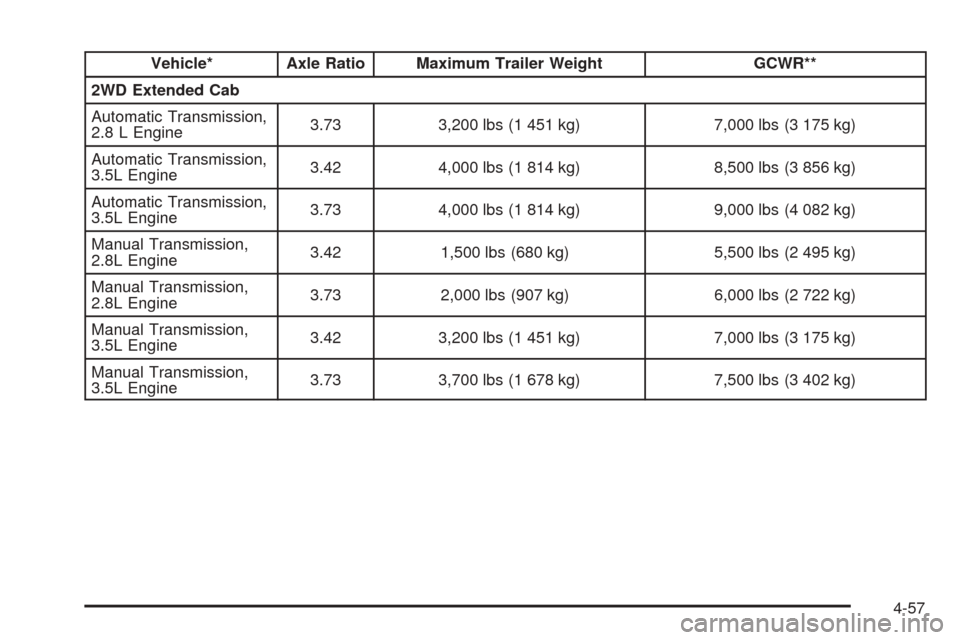
Vehicle* Axle Ratio Maximum Trailer Weight GCWR**
2WD Extended Cab
Automatic Transmission,
2.8 L Engine3.73 3,200 lbs (1 451 kg) 7,000 lbs (3 175 kg)
Automatic Transmission,
3.5L Engine3.42 4,000 lbs (1 814 kg) 8,500 lbs (3 856 kg)
Automatic Transmission,
3.5L Engine3.73 4,000 lbs (1 814 kg) 9,000 lbs (4 082 kg)
Manual Transmission,
2.8L Engine3.42 1,500 lbs (680 kg) 5,500 lbs (2 495 kg)
Manual Transmission,
2.8L Engine3.73 2,000 lbs (907 kg) 6,000 lbs (2 722 kg)
Manual Transmission,
3.5L Engine3.42 3,200 lbs (1 451 kg) 7,000 lbs (3 175 kg)
Manual Transmission,
3.5L Engine3.73 3,700 lbs (1 678 kg) 7,500 lbs (3 402 kg)
4-57
Page 256 of 414
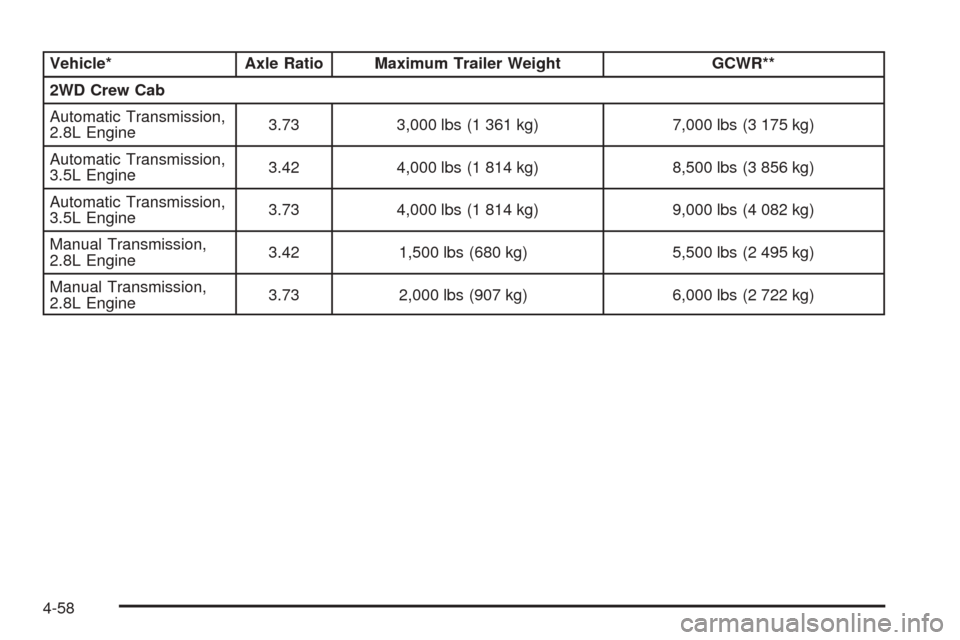
Vehicle* Axle Ratio Maximum Trailer Weight GCWR**
2WD Crew Cab
Automatic Transmission,
2.8L Engine3.73 3,000 lbs (1 361 kg) 7,000 lbs (3 175 kg)
Automatic Transmission,
3.5L Engine3.42 4,000 lbs (1 814 kg) 8,500 lbs (3 856 kg)
Automatic Transmission,
3.5L Engine3.73 4,000 lbs (1 814 kg) 9,000 lbs (4 082 kg)
Manual Transmission,
2.8L Engine3.42 1,500 lbs (680 kg) 5,500 lbs (2 495 kg)
Manual Transmission,
2.8L Engine3.73 2,000 lbs (907 kg) 6,000 lbs (2 722 kg)
4-58
Page 257 of 414
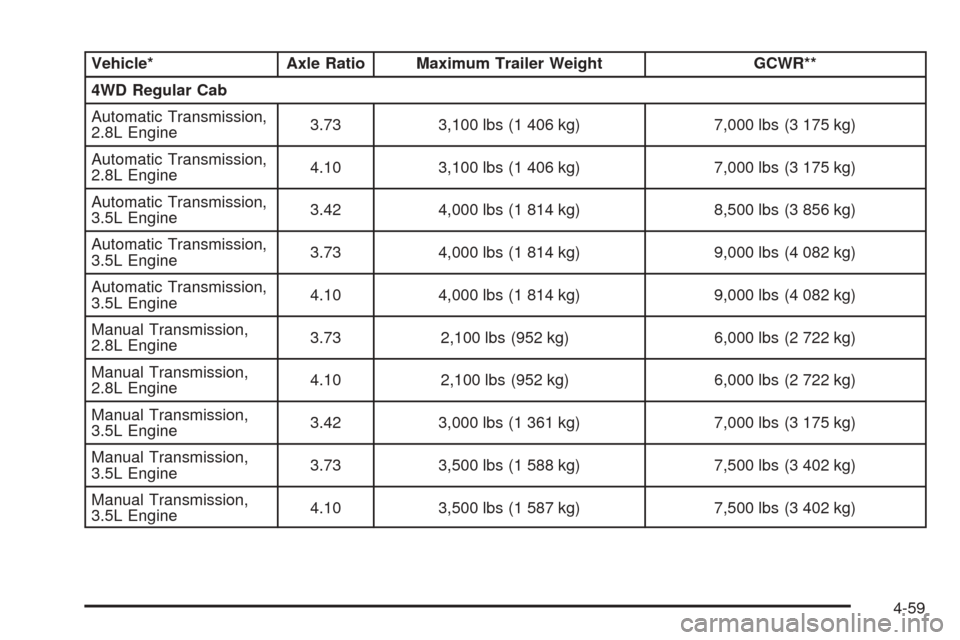
Vehicle* Axle Ratio Maximum Trailer Weight GCWR**
4WD Regular Cab
Automatic Transmission,
2.8L Engine3.73 3,100 lbs (1 406 kg) 7,000 lbs (3 175 kg)
Automatic Transmission,
2.8L Engine4.10 3,100 lbs (1 406 kg) 7,000 lbs (3 175 kg)
Automatic Transmission,
3.5L Engine3.42 4,000 lbs (1 814 kg) 8,500 lbs (3 856 kg)
Automatic Transmission,
3.5L Engine3.73 4,000 lbs (1 814 kg) 9,000 lbs (4 082 kg)
Automatic Transmission,
3.5L Engine4.10 4,000 lbs (1 814 kg) 9,000 lbs (4 082 kg)
Manual Transmission,
2.8L Engine3.73 2,100 lbs (952 kg) 6,000 lbs (2 722 kg)
Manual Transmission,
2.8L Engine4.10 2,100 lbs (952 kg) 6,000 lbs (2 722 kg)
Manual Transmission,
3.5L Engine3.42 3,000 lbs (1 361 kg) 7,000 lbs (3 175 kg)
Manual Transmission,
3.5L Engine3.73 3,500 lbs (1 588 kg) 7,500 lbs (3 402 kg)
Manual Transmission,
3.5L Engine4.10 3,500 lbs (1 587 kg) 7,500 lbs (3 402 kg)
4-59
Page 258 of 414
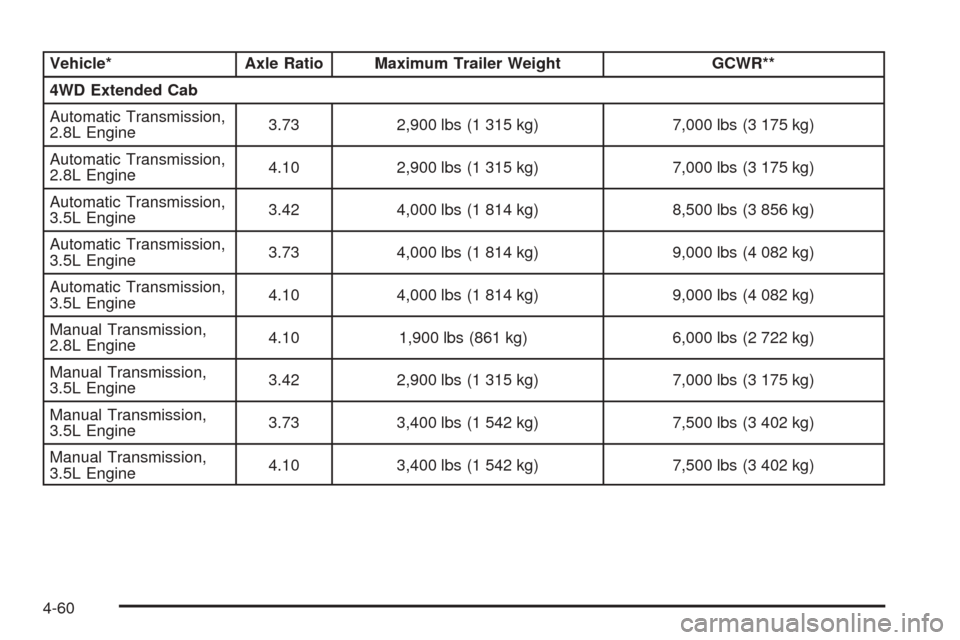
Vehicle* Axle Ratio Maximum Trailer Weight GCWR**
4WD Extended Cab
Automatic Transmission,
2.8L Engine3.73 2,900 lbs (1 315 kg) 7,000 lbs (3 175 kg)
Automatic Transmission,
2.8L Engine4.10 2,900 lbs (1 315 kg) 7,000 lbs (3 175 kg)
Automatic Transmission,
3.5L Engine3.42 4,000 lbs (1 814 kg) 8,500 lbs (3 856 kg)
Automatic Transmission,
3.5L Engine3.73 4,000 lbs (1 814 kg) 9,000 lbs (4 082 kg)
Automatic Transmission,
3.5L Engine4.10 4,000 lbs (1 814 kg) 9,000 lbs (4 082 kg)
Manual Transmission,
2.8L Engine4.10 1,900 lbs (861 kg) 6,000 lbs (2 722 kg)
Manual Transmission,
3.5L Engine3.42 2,900 lbs (1 315 kg) 7,000 lbs (3 175 kg)
Manual Transmission,
3.5L Engine3.73 3,400 lbs (1 542 kg) 7,500 lbs (3 402 kg)
Manual Transmission,
3.5L Engine4.10 3,400 lbs (1 542 kg) 7,500 lbs (3 402 kg)
4-60
Page 259 of 414

Vehicle* Axle Ratio Maximum Trailer Weight GCWR**
4WD Crew Cab
Automatic Transmission,
2.8L Engine3.73 2,700 lbs (1 225 kg) 7,000 lbs (3 175 kg)
Automatic Transmission,
2.8L Engine4.10 2,700 lbs (1 225 kg) 7,000 lbs (3 175 kg)
Automatic Transmission,
3.5L Engine3.42 4,000 lbs (1 814 kg) 8,500 lbs (3 856 kg)
Automatic Transmission,
3.5L Engine3.73 4,000 lbs (1 814 kg) 9,000 lbs (4 082 kg)
Automatic Transmission,
3.5L Engine4.10 4,000 lbs (1 814 kg) 9,000 lbs (4 082 kg)
Manual Transmission,
2.8L Engine4.10 1,700 lbs (771 kg) 6,000 lbs (2 721 kg)
**The Gross Combination Weight Rating (GCWR) is the
total allowable weight of the completely loaded vehicle
and trailer including any passengers, cargo, equipment
and conversions. The GCWR for your vehicle should
not be exceeded.
You can ask your dealer for our trailering information
or advice, or you can write us at the address listed
in your Warranty and Owner Assistance Information
Booklet.In Canada, write to:
General Motors of Canada Limited
Customer Communication Centre, 163-005
1908 Colonel Sam Drive
Oshawa, Ontario L1H 8P7
4-61
Page 264 of 414
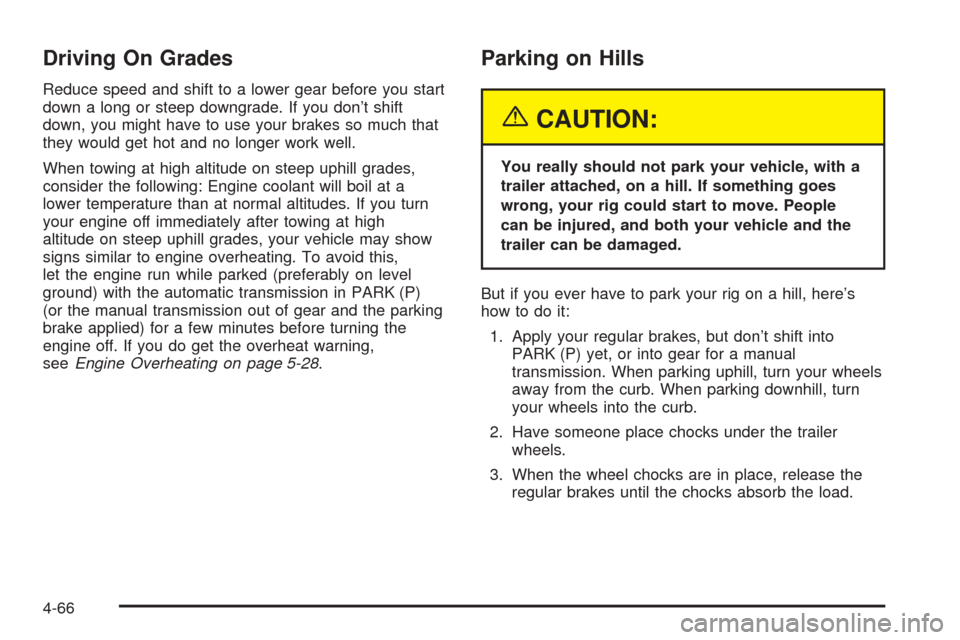
Driving On Grades
Reduce speed and shift to a lower gear before you start
down a long or steep downgrade. If you don’t shift
down, you might have to use your brakes so much that
they would get hot and no longer work well.
When towing at high altitude on steep uphill grades,
consider the following: Engine coolant will boil at a
lower temperature than at normal altitudes. If you turn
your engine off immediately after towing at high
altitude on steep uphill grades, your vehicle may show
signs similar to engine overheating. To avoid this,
let the engine run while parked (preferably on level
ground) with the automatic transmission in PARK (P)
(or the manual transmission out of gear and the parking
brake applied) for a few minutes before turning the
engine off. If you do get the overheat warning,
seeEngine Overheating on page 5-28.
Parking on Hills
{CAUTION:
You really should not park your vehicle, with a
trailer attached, on a hill. If something goes
wrong, your rig could start to move. People
can be injured, and both your vehicle and the
trailer can be damaged.
But if you ever have to park your rig on a hill, here’s
how to do it:
1. Apply your regular brakes, but don’t shift into
PARK (P) yet, or into gear for a manual
transmission. When parking uphill, turn your wheels
away from the curb. When parking downhill, turn
your wheels into the curb.
2. Have someone place chocks under the trailer
wheels.
3. When the wheel chocks are in place, release the
regular brakes until the chocks absorb the load.
4-66
Page 265 of 414
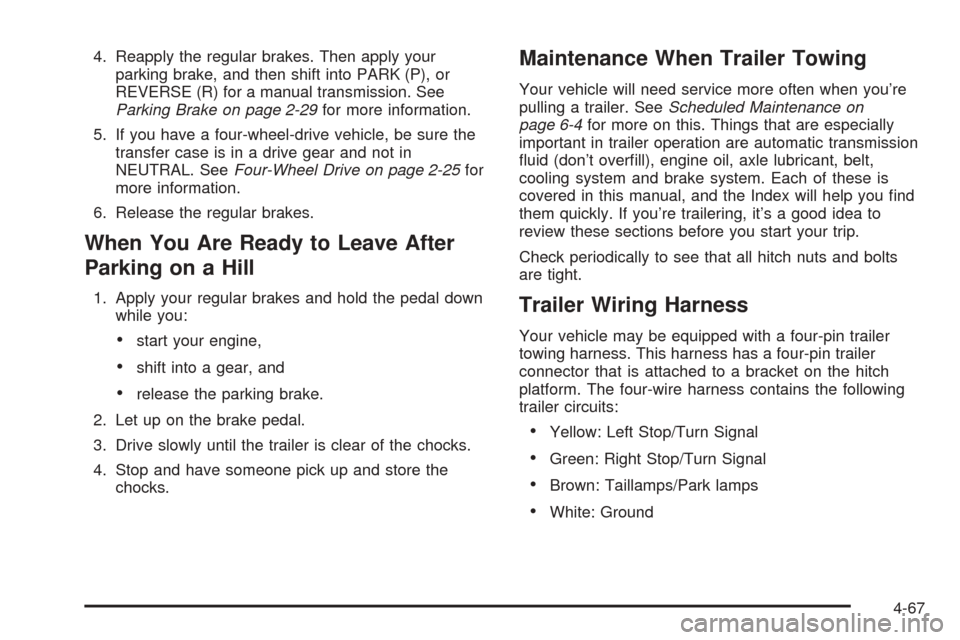
4. Reapply the regular brakes. Then apply your
parking brake, and then shift into PARK (P), or
REVERSE (R) for a manual transmission. See
Parking Brake on page 2-29for more information.
5. If you have a four-wheel-drive vehicle, be sure the
transfer case is in a drive gear and not in
NEUTRAL. SeeFour-Wheel Drive on page 2-25for
more information.
6. Release the regular brakes.
When You Are Ready to Leave After
Parking on a Hill
1. Apply your regular brakes and hold the pedal down
while you:
start your engine,
shift into a gear, and
release the parking brake.
2. Let up on the brake pedal.
3. Drive slowly until the trailer is clear of the chocks.
4. Stop and have someone pick up and store the
chocks.
Maintenance When Trailer Towing
Your vehicle will need service more often when you’re
pulling a trailer. SeeScheduled Maintenance on
page 6-4for more on this. Things that are especially
important in trailer operation are automatic transmission
�uid (don’t over�ll), engine oil, axle lubricant, belt,
cooling system and brake system. Each of these is
covered in this manual, and the Index will help you �nd
them quickly. If you’re trailering, it’s a good idea to
review these sections before you start your trip.
Check periodically to see that all hitch nuts and bolts
are tight.
Trailer Wiring Harness
Your vehicle may be equipped with a four-pin trailer
towing harness. This harness has a four-pin trailer
connector that is attached to a bracket on the hitch
platform. The four-wire harness contains the following
trailer circuits:
Yellow: Left Stop/Turn Signal
Green: Right Stop/Turn Signal
Brown: Taillamps/Park lamps
White: Ground
4-67
Page 267 of 414

Service............................................................5-3
Doing Your Own Service Work.........................5-4
Adding Equipment to the Outside
of Your Vehicle...........................................5-5
Fuel................................................................5-5
Gasoline Octane............................................5-5
Gasoline Speci�cations....................................5-5
California Fuel...............................................5-6
Additives.......................................................5-6
Fuels in Foreign Countries...............................5-7
Filling the Tank..............................................5-8
Filling a Portable Fuel Container.....................5-10
Checking Things Under the Hood....................5-10
Hood Release..............................................5-11
Engine Compartment Overview.......................5-12
Engine Oil...................................................5-13
Engine Oil Life System..................................5-16
Engine Air Cleaner/Filter................................5-18
Automatic Transmission Fluid.........................5-19
Manual Transmission Fluid.............................5-22
Hydraulic Clutch...........................................5-24
Engine Coolant.............................................5-25
Radiator Pressure Cap..................................5-27
Engine Overheating.......................................5-28
Cooling System............................................5-29
Engine Fan Noise.........................................5-34Power Steering Fluid.....................................5-34
Windshield Washer Fluid................................5-35
Brakes........................................................5-36
Battery........................................................5-39
Jump Starting...............................................5-40
Rear Axle.......................................................5-44
Four-Wheel Drive............................................5-44
Front Axle......................................................5-45
Bulb Replacement..........................................5-46
Halogen Bulbs..............................................5-46
Headlamps..................................................5-46
Front Turn Signal, Sidemarker and Daytime
Running Lamps.........................................5-48
Center High-Mounted Stoplamp (CHMSL).........5-48
Taillamps, Turn Signal, Stoplamps and
Back-up Lamps.........................................5-49
Replacement Bulbs.......................................5-50
Windshield Wiper Blade Replacement..............5-50
Tires..............................................................5-52
Tire Sidewall Labelling...................................5-53
Tire Terminology and De�nitions.....................5-56
In�ation - Tire Pressure.................................5-58
Tire Inspection and Rotation...........................5-60
When It Is Time for New Tires.......................5-61
Section 5 Service and Appearance Care
5-1